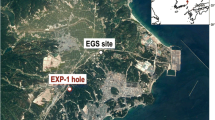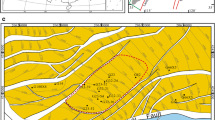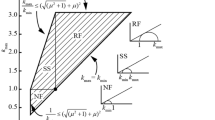Abstract
The hydraulic fracturing of horizontal wells is a key stimulation technology for unconventional tight oil/gas reservoirs. Good knowledge of the near-well stress field of a horizontal well can be helpful for the hydraulic fracture design optimization of new wells and refrac design optimization of fractured wells. Azimuth and dip data derived from either focal mechanisms of hydraulic fracturing-induced microseismic events or fracture attributes of hydraulic fracture networks can be used for new-well stress field inversion. In this work, we present a novel stress inversion method integrating azimuth, dip, and rake data from the focal mechanisms of hydraulically induced microseismic events and fracture attributes of hydraulic fracture networks. For those stages having sufficient reliable microseismic focal mechanisms, strike, dip, and rake data derived from microseismic focal mechanisms are taken as input data for stress inversion. Meanwhile, for those stages that have no microseismic events or insufficient reliable microseismic focal mechanisms, azimuth and dip data derived from fracture attributes of prebuilt hydraulic fracture network are used for stress inversion, along with azimuth, dip, and rake data derived from other stages with sufficient reliable microseismic focal mechanisms. Thus, the near-well stress field of each stage can be inverted, regardless of whether or not it has hydraulically induced microseismic events. The new method has been applied in the field surface microseismic dataset during hydraulic fracture stimulation. The results reveal that the inverted near-well stress fields are consistent with the stress orientation derived from shear-wave splitting analysis for sonic logs. This finding demonstrates that the stress inversion method based on strike, dip, and rake data derived from microseismic focal mechanisms and fracture networks can correctly obtain the azimuths of maximum and minimum horizontal stress.
Similar content being viewed by others
References
Andersen, L. 2001, A relative moment tensor inversion technique applied to seismicity induced by mining, University of the Witwatersrand, Johannesburg.
Artun, E., and B. Kulga. 2020, Selection of candidate wells for re-fracturing in tight gas sand reservoirs using fuzzy inference. Petroleum Exploration and Development.
Baig, A., and T. Urbancic. 2010, Microseismic moment tensors: A path to understanding frac growth. The Leading Edge, 29, no. 3, 320–324.
Colmenares, L., and M. Zoback. 2002, A statistical evaluation of intact rock failure criteria constrained by polyaxial test data for five different rocks. International Journal of Rock Mechanics and Mining Sciences, 39, no. 6, 695–729.
Deng, H., W. Zhou, H. Jiang, and W. Jiang. 2009, Current terrestrial stress direction of the Shaximiao Formation in the Yanjinggou Structure of the West Sichuan Depression. Oil & Gas Geology, 30, no. 6, 720–725.
Ding, W., T. Fan, B. Yu, X. Huang, and C. Liu. 2012, Ordovician carbonate reservoir fracture characteristics and fracture distribution forecasting in the Tazhong area of Tarim Basin, Northwest China. Journal of Petroleum Science and Engineering, 86, 62–70.
Ding, W., S. Yin, X. Wang, N. Zhang, M. Zhang, and X. Cao. 2015, Assessment method and characterization of tight sandstone gas reservoir fractures. Earth Science Frontiers, 22, no. 4, 173–187.
Ding, W., D. Zhu, J. Cai, M. Gong, and F. Chen. 2013, Analysis of the developmental characteristics and major regulating factors of fractures in marine-continental transitional shale-gas reservoirs: A case study of the Carboniferous-Permian strata in the southeastern Ordos Basin, central China. Marine and Petroleum Geology, 45, 121–133.
Duncan Peter, M., and L. Eisner. 2010, Reservoir characterization using surface microseismic monitoring. Geophysics, 75, no. 5, 139–146.
Fan, T., G. Zhang, and J. Cui. 2014, The impact of cleats on hydraulic fracture initiation and propagation in coal seams. Petroleum Science, 11, 532–539.
Feng, G.-L., X.-T. Feng, B.-R. Chen, Y.-X. Xiao, and Q. Jiang. 2015, Sectional velocity model for microseismic source location in tunnels. Tunnelling and Underground Space Technology, 45, 73–83.
Gilbert, F. 1971, Excitation of the normal modes of the Earth by earthquake sources. Geophysical Journal International, 22, no. 2, 223–226.
Hara, S., Y. Fukahata, and Y. Iio. 2019, P-wave first-motion polarity determination of waveform data in western Japan using deep learning. Earth, Planets and Space, 71, no. 1, 127.
Hugot, A., J.-C. Dulac, E. Gringarten, and A. Haouesse. 2015, Connecting the dots: Microseismic-derived connectivity for estimating reservoir volumes in low-permeability reservoirs. Paper read at Unconventional Resources Technology Conference, at San Antonio, Texas.
Jia, A., Y. Wei, Z. Guo, G. Wang, D. Meng, and S. Huang. 2022, Development status and prospect of tight sandstone gas in China. Natural Gas Industry, 42, no. 01, 83–92.
Kang, H.-p., X. Zhang, L.-p. Si, Y. Wu, and F. Gao. 2010, In-situ stress measurements and stress distribution characteristics in underground coal mines in China. Engineering Geology, 116, no. 3–4, 333–345.
Kong, L., M. Ostadhassan, N. Tamimi, S. Samani, and C. Li. 2019, Refracturing: well selection, treatment design, and lessons learned—a review. Arabian Journal of Geosciences, 12, 1–13.
Kwiatek, G., P. Martínez-Garzón, and M. Bohnhoff. 2016, HybridMT: A MATLAB/shell environment package for seismic moment tensor inversion and refinement. Seismological Research Letters, 87, no. 4, 964–976.
Li, L., G. Zhang, X. Pan, X. Guo, J. Zhang, Y. Zhou, and Y. Lin. 2022, Anisotropic poroelasticity and AVAZ inversion for in situ stress estimate in fractured shale-gas reservoirs. IEEE Transactions on Geoscience and Remote Sensing, 60, 1–13.
Lin, H., F. Zhou, Y. Tian, and Y. Wang. 2022, Prediction of Refracturing Effect of Tight Gas Reservoirs Based on Bayesian Inversion Algorithm. Computational Intelligence and Neuroscience, 2022.
Liu, H., Z. Lan, G. Zhang, F. Hou, X. He, and X. Liu. 2008, Evaluation of refracture reorientation in both laboratory and field scales. Paper read at SPE International Symposium and Exhibition on Formation Damage Control.
Maxwell, S. 2014, Microseismic imaging of hydraulic fracturing: Improved engineering of unconventional shale reservoirs: Society of Exploration Geophysicists.
Michael, A. J. 1984, Determination of stress from slip data: faults and folds. Journal of Geophysical Research: Solid Earth, 89, no. B13, 11517–11526.
Moos, D., and M. D. Zoback. 1990, Utilization of observations of well bore failure to constrain the orientation and magnitude of crustal stresses: application to continental, Deep Sea Drilling Project, and Ocean Drilling Program boreholes. Journal of Geophysical Research: Solid Earth, 95, no. B6, 9305–9325.
Nolen-Hoeksema, R. C., and L. J. Ruff. 2001, Moment tensor inversion of microseisms from the B-sand propped hydrofracture, M-site, Colorado. Tectonophysics, 336, no. 1–4, 163–181.
Paul, S., and R. Chatterjee. 2011, Determination of in-situ stress direction from cleat orientation mapping for coal bed methane exploration in south-eastern part of Jharia coalfield, India. International Journal of Coal Geology, 87, no. 2, 87–96.
Ramamurthy, T. 1993, Strength and modulus responses of anisotropic sedimentary rocks: Comprehensive rock engineering.
Ross, Z. E., M. A. Meier, and E. Hauksson. 2018, P wave arrival picking and first-motion polarity determination with deep learning. Journal of Geophysical Research: Solid Earth, 123, no. 6, 5120–5129.
Schmoker, J. W. 1996, A resource evaluation of the bakken formation (Upper Devonian and Lower Mississippian) continuous oil accumulation, Williston Basin, North Dakota and Montana. The Mountain Geologist.
Settari, A., and M. P. Cleary. 1984, Three-dimensional simulation of hydraulic fracturing. Journal of Petroleum Technology, 36, no. 07, 1177–1190.
Tian, Y., and M. H. Ritzwoller. 2015, Directionality of ambient noise on the Juan de Fuca plate: implications for source locations of the primary and secondary microseisms. Geophysical Journal International, 201, no. 1, 429–443.
Uchide, T. 2020, Focal mechanisms of small earthquakes beneath the Japanese islands based on first-motion polarities picked using deep learning. Geophysical Journal International, 223, no. 3, 1658–1671.
Vavryčuk, V. 2014, Iterative joint inversion for stress and fault orientations from focal mechanisms. Geophysical Journal International, 199, no. 1, 69–77.
Wang, Y., R. Watson, J. Rostami, J. Y. Wang, M. Limbruner, and Z. He. 2014, Study of borehole stability of Marcellus shale wells in longwall mining areas. Journal of Petroleum Exploration and Production Technology, 4, 59–71.
Xiao, F., D. Huang, B. Zhang, D. Tang, Q. Ran, Q. Tang, and H. Yin. 2019, Geochemical characteristics and geological significance of natural gas in Jurassic Shaximiao Formation, Sichuan Basin. Acta Petrolei Sinica, 40, no. 5, 568–576, 586.
Xiao, F., T. Wei, X. Wang, X. Guan, and C. Wu. 2020, Research on the sequence stratigraphy of the Shaximiao Formation in Chuanzhong-Chuanxi area,Sichuan Basin. Natural Gas Geoscience, 31, no. 09, 1216–1224.
Xiaoqing, C. 2019, Research on microseismic fracture interpretation techniques based on focal mechanism, China University of Petroleum, Beijing.
Yang, R., D. Li, H. Pang, and T. Ma. 2017, Fracture imaging of the surface based microseismic monitoring in shale gas fracking: methods and application. Natural gas industry, 37, no. 05, 31–37.
Zeng, L., J. Jiang, and Y. Yang. 2010, Fractures in the low porosity and ultra-low permeability glutenite reservoirs: A case study of the late Eocene Hetaoyuan formation in the Anpeng Oilfield, Nanxiang Basin, China. Marine and Petroleum Geology, 27, no. 7, 1642–1650.
Zoback, M. D., C. Barton, M. Brudy, D. Castillo, T. Finkbeiner, B. Grollimund, D. Moos, P. Peska, C. Ward, and D. Wiprut. 2003, Determination of stress orientation and magnitude in deep wells. International Journal of Rock Mechanics and Mining Sciences, 40, no. 7–8, 1049–1076.
Zou, C. 2017, Unconventional petroleum geology: Elsevier.
Zúñiga, F. R., R. R. Castro, and T. Domínguez. 1995, Stress orientation and anisotropy based on shear-wave splitting observations in the Cerro Prieto fault area, Baja California, Mexico. pure and applied geophysics, 144, no. 1, 39–57. doi: https://doi.org/10.1007/BF00876473.
Acknowledgments
This work is supported by the Fundamental Research Funds for the Central Universities (No. 2022JCCXMT01). We would like to acknowledge and express our gratitude to the Tight Oil and Gas Exploration and Development Project Department of PetroChina for providing the microseismic datasets used in this research. Additionally, we would like to extend our appreciation to OptaSoft, which provided technical support and enabled microseismic data processing throughout the research process.
Author information
Authors and Affiliations
Corresponding author
Additional information
This work was supported by the Fundamental Research Funds for the Central Universities (No. 2022JCCXMT01).
Chao Xu is a PhD candidate at China University of Mining and Technology (Beijing). His main work is passive seismic signal processing and interpretation. His main research interests include shallow surface seismic exploration, unconventional oil and gas exploration, and geothermal exploration. His contact information is China University of Mining and Technology (Beijing), 11 Ding Xueyuan Road, Haidian District, Beijing 10083, China. His email address is maple_xc@163.com
Rights and permissions
About this article
Cite this article
Xu, C., Yang, R., Zhao, Z. et al. Method and Application of Stress Inversion based on Strike, Dip, and Rake Data from Microseismic Focal Mechanisms and Fracture Network. Appl. Geophys. (2024). https://doi.org/10.1007/s11770-024-1091-x
Received:
Revised:
Published:
DOI: https://doi.org/10.1007/s11770-024-1091-x




